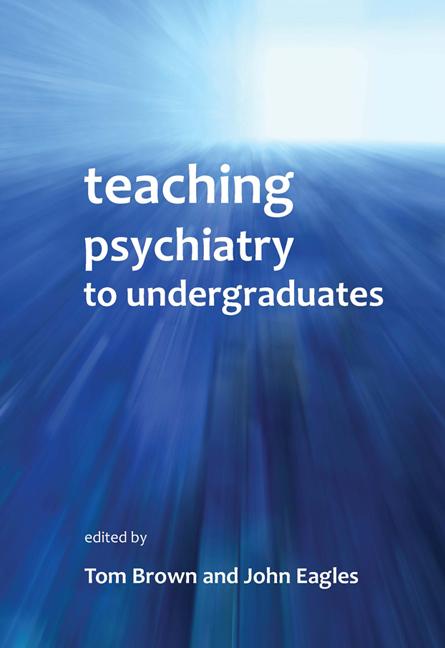Book contents
- Frontmatter
- Contents
- List of figures, tables and boxes
- List of contributors
- Preface
- Foreword
- 1 How do students learn?
- 2 Recent developments in undergraduate medical education
- 3 Undergraduate psychiatry teaching – the core curriculum
- 4 The organisation of undergraduate teaching
- 5 Assessment of undergraduates in psychiatry
- 6 Using computers to teach undergraduate psychiatry
- 7 How to give a lecture
- 8 How to do small-group teaching
- 9 Problem-based learning
- 10 Teaching trainee psychiatrists how to teach medical students: the Southampton model
- 11 Involving trainees in teaching
- 12 Involvement of service users in psychiatric education
- 13 Time-efficient clinical teaching
- 14 Intercalated degrees
- 15 Undergraduate experiences of psychiatry: a student view
- 16 Integration: teaching psychiatry with other specialties
- 17 Teaching the teachers in a cross-cultural setting: the Scotland–Malawi Mental Health Education Project
- 18 International undergraduate teaching
- 19 Teaching with simulated patients and role-play
- 20 Undergraduate medical education and recruitment to psychiatry
- 21 Choosing psychiatry: factors influencing career choice among foundation doctors in Scotland
- 22 Funding of the teaching of medical undergraduates
- 23 Dealing with students in difficulty
- 24 Training medical students to promote good mental health in secondary schools
- 25 Women in medicine
- Index
13 - Time-efficient clinical teaching
- Frontmatter
- Contents
- List of figures, tables and boxes
- List of contributors
- Preface
- Foreword
- 1 How do students learn?
- 2 Recent developments in undergraduate medical education
- 3 Undergraduate psychiatry teaching – the core curriculum
- 4 The organisation of undergraduate teaching
- 5 Assessment of undergraduates in psychiatry
- 6 Using computers to teach undergraduate psychiatry
- 7 How to give a lecture
- 8 How to do small-group teaching
- 9 Problem-based learning
- 10 Teaching trainee psychiatrists how to teach medical students: the Southampton model
- 11 Involving trainees in teaching
- 12 Involvement of service users in psychiatric education
- 13 Time-efficient clinical teaching
- 14 Intercalated degrees
- 15 Undergraduate experiences of psychiatry: a student view
- 16 Integration: teaching psychiatry with other specialties
- 17 Teaching the teachers in a cross-cultural setting: the Scotland–Malawi Mental Health Education Project
- 18 International undergraduate teaching
- 19 Teaching with simulated patients and role-play
- 20 Undergraduate medical education and recruitment to psychiatry
- 21 Choosing psychiatry: factors influencing career choice among foundation doctors in Scotland
- 22 Funding of the teaching of medical undergraduates
- 23 Dealing with students in difficulty
- 24 Training medical students to promote good mental health in secondary schools
- 25 Women in medicine
- Index
Summary
Introduction
As service pressures increase, so do demands on clinician teachers. Yet opportunities for effective clinical teaching abound, even in a busy service. Nearly every aspect of a psychiatrist's work offers educational value and may be imparted through different teaching methods. This chapter provides illustrations of evidence-based approaches to the time-efficient clinical teaching of one or two medical students on attachment, and should apply to any psychiatric specialty.
Teaching may be integrated into ward rounds, out-patient clinics, home visits and other clinical encounters. The challenge is to provide simultaneous high-quality teaching and clinical care without compromising either (Cantillon, 2003; Doshi & Brown, 2005). With adequate planning and team involvement, integrated teaching can achieve more than the educational objectives expected by students. It may also enhance positive role-modelling, reflective practice and both trainee and trainer satisfaction. Ultimately, it is hoped that a positive clinical experience will encourage more students to choose a career in the exciting field that is psychiatry.
Educational background (see also Chapter 1)
Patient-based teaching offers improved relevance and recall, lifelike preparation and transferable skills (Dent, 2001; Hartley et al, 2003; Spencer, 2003). Integrating time-efficient, patient-based teaching into ambulatory and ward settings is challenging not least because of the competing demands on the clinician's time. Student participation may decrease productivity and lengthen the working day, hence the need for time-efficient integrated teaching strategies (Usatine et al, 1997).
One intention of clinical teaching is to foster deep learning, a process which, through seeking connection and thinking about the whole picture, results in improved understanding. Deep learning is the opposite style to surface learning, which is largely about memorising (Marton & Saljo, 1976). Students who adopt a surface learning approach are more likely to fail and to gain poorer, lower-marked degrees (Butcher, 1995). Fostering a deep approach to learning involves enhancing student motivation and involvement, interaction with others and a well-structured knowledge base (Butcher, 1995).
The experiential learning model states that learning is most effective when based on direct experience (Kolb, 1984). The model describes a cycle that involves engagement in a new experience, feedback and reflection, formulation of sound theories, and application of these theories in new situations.
- Type
- Chapter
- Information
- Teaching Psychiatry to Undergraduates , pp. 152 - 161Publisher: Royal College of PsychiatristsPrint publication year: 2011

